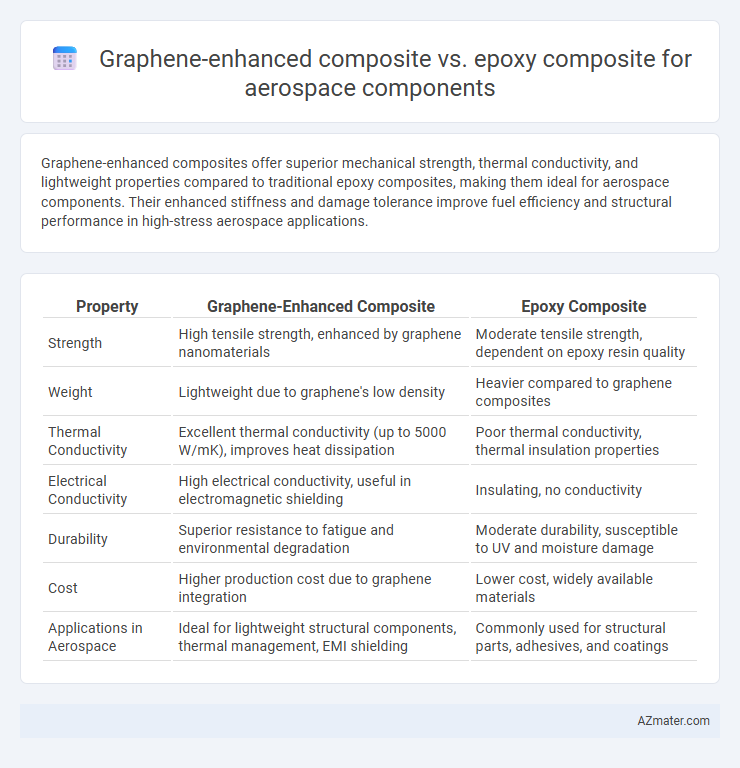Graphene-enhanced composites offer superior mechanical strength, thermal conductivity, and lightweight properties compared to traditional epoxy composites, making them ideal for aerospace components. Their enhanced stiffness and damage tolerance improve fuel efficiency and structural performance in high-stress aerospace applications.
Table of Comparison
| Property | Graphene-Enhanced Composite | Epoxy Composite |
|---|---|---|
| Strength | High tensile strength, enhanced by graphene nanomaterials | Moderate tensile strength, dependent on epoxy resin quality |
| Weight | Lightweight due to graphene's low density | Heavier compared to graphene composites |
| Thermal Conductivity | Excellent thermal conductivity (up to 5000 W/mK), improves heat dissipation | Poor thermal conductivity, thermal insulation properties |
| Electrical Conductivity | High electrical conductivity, useful in electromagnetic shielding | Insulating, no conductivity |
| Durability | Superior resistance to fatigue and environmental degradation | Moderate durability, susceptible to UV and moisture damage |
| Cost | Higher production cost due to graphene integration | Lower cost, widely available materials |
| Applications in Aerospace | Ideal for lightweight structural components, thermal management, EMI shielding | Commonly used for structural parts, adhesives, and coatings |
Introduction to Composite Materials in Aerospace
Graphene-enhanced composites exhibit superior mechanical strength, thermal conductivity, and electrical properties compared to traditional epoxy composites, making them highly suitable for aerospace components requiring lightweight and high-performance materials. Epoxy composites, widely used in aerospace, offer excellent adhesion, chemical resistance, and ease of fabrication but are limited by lower thermal and electrical conductivities. Advances in graphene integration into composite matrices significantly improve stiffness, impact resistance, and durability, driving innovation in aerospace structural materials.
Overview of Epoxy Composites
Epoxy composites are widely used in aerospace components due to their excellent mechanical properties, high strength-to-weight ratio, and superior chemical resistance. These thermosetting polymers provide efficient load transfer and durability under extreme temperature and environmental conditions, making them ideal for structural aerospace applications. The widespread adoption of epoxy composites stems from their ease of processing and ability to bond strongly with reinforcing fibers like carbon and glass.
Fundamentals of Graphene-Enhanced Composites
Graphene-enhanced composites exhibit superior mechanical properties compared to traditional epoxy composites, including increased tensile strength, thermal conductivity, and electrical conductivity due to graphene's exceptional atomic structure. The integration of graphene nanosheets within the epoxy matrix improves load transfer efficiency and fracture toughness, which is critical for aerospace components subjected to high stress and temperature variations. These fundamental enhancements enable the development of lightweight, durable aerospace materials that outperform conventional epoxy composites in performance and resilience.
Comparative Mechanical Properties
Graphene-enhanced composites exhibit significantly higher tensile strength and fracture toughness compared to traditional epoxy composites, making them ideal for aerospace components subjected to extreme mechanical stress. Their superior stiffness and fatigue resistance contribute to improved durability and longer service life in high-performance aerospace structures. Epoxy composites, while lightweight and cost-effective, generally offer lower mechanical resilience and are more prone to micro-cracking under cyclic loading conditions.
Weight Reduction and Structural Efficiency
Graphene-enhanced composites offer significant weight reduction compared to traditional epoxy composites by incorporating graphene's exceptional strength-to-weight ratio, resulting in lighter aerospace components without compromising structural integrity. The integration of graphene enhances load-bearing capacity and impact resistance, leading to improved structural efficiency and durability under extreme aerospace conditions. Aerospace manufacturers prioritize graphene composites for their ability to optimize performance while minimizing the overall mass of critical components.
Thermal and Electrical Conductivity Comparison
Graphene-enhanced composites exhibit significantly higher thermal conductivity, reaching up to 1500 W/mK, compared to traditional epoxy composites with thermal conductivity typically below 0.5 W/mK. Electrical conductivity in graphene-enhanced composites increases dramatically, enabling improved electromagnetic interference shielding and static dissipation essential for aerospace applications. The enhanced heat dissipation and electrical performance contribute to greater reliability and efficiency in aerospace components exposed to extreme operational conditions.
Durability and Fatigue Resistance Analysis
Graphene-enhanced composites demonstrate superior durability and fatigue resistance compared to traditional epoxy composites, attributed to graphene's exceptional mechanical strength and crack-arresting properties. The integration of graphene nanoparticles significantly improves the composite's ability to withstand cyclic loading and resist microcrack propagation, resulting in extended service life for aerospace components. Advanced studies reveal that graphene composites exhibit up to 30% higher fatigue life and enhanced impact resistance, making them highly suitable for critical aerospace applications requiring robust structural integrity.
Manufacturing Processes and Scalability
Graphene-enhanced composites offer superior mechanical strength and thermal conductivity compared to traditional epoxy composites, enabling improved aerospace component performance. Manufacturing processes for graphene composites, such as solution mixing, chemical vapor deposition, and layer-by-layer assembly, demand precise control but are increasingly scalable with advancements in automated deposition and dispersion techniques. While epoxy composites benefit from well-established, cost-effective manufacturing routes like vacuum infusion and autoclave curing, graphene composites are steadily reaching industrial scalability through optimized synthesis and integration methods.
Cost Considerations and Market Trends
Graphene-enhanced composites exhibit higher initial material costs than traditional epoxy composites due to complex production processes, but they offer superior mechanical strength and thermal conductivity that reduce long-term maintenance expenses in aerospace components. Market trends reveal increasing investments in graphene technology driven by demand for lightweight, high-performance materials to improve fuel efficiency and durability in aircraft manufacturing. Cost-benefit analyses suggest that despite upfront expenses, graphene composites possess a growing competitive advantage in aerospace applications as scalable manufacturing methods advance.
Future Prospects in Aerospace Applications
Graphene-enhanced composites exhibit superior mechanical strength, thermal conductivity, and lightweight properties compared to traditional epoxy composites, making them ideal for future aerospace applications such as structural components and thermal management systems. Their enhanced durability and resistance to fatigue and corrosion promise extended service life and reduced maintenance costs for aircraft and spacecraft. Ongoing advancements in scalable production and integration techniques are expected to accelerate the adoption of graphene composites in next-generation aerospace designs, driving innovation in fuel efficiency and performance.

Infographic: Graphene-enhanced composite vs Epoxy composite for Aerospace component
 azmater.com
azmater.com